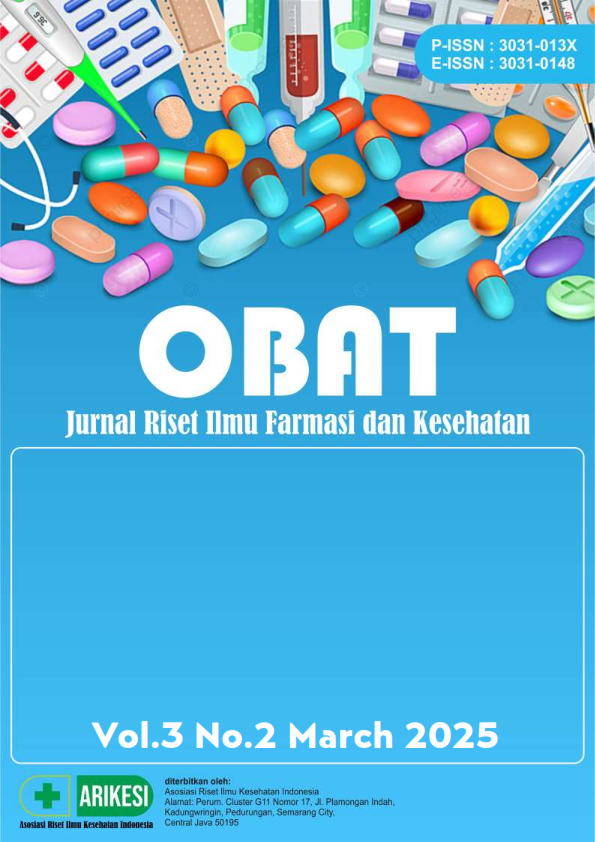Gap Analysis CPOB 2018 Terhadap Rancangan Revisi CPOB 2024 Aneks 1 Pembuatan Produk Steril Aspek Peralatan, Sarana Penunjang, dan Personalia
DOI:
https://doi.org/10.61132/obat.v3i2.1136Keywords:
GMP, Gap Analysis, Pharmaceutical IndustryAbstract
The pharmaceutical industry operates under a strict regulatory framework to ensure that the products produced are safe, of high quality, and effective. These regulations are continuously updated to keep up with advancements in science, technological developments, and global demands for higher quality standards. The pharmaceutical industry also faces the challenge of global regulatory harmonization, such as standards set by WHO and PIC/S. These regulations are designed to ensure drug quality from development to distribution. Changes in Good Manufacturing Practices (GMP) regulations are crucial for improving pharmaceutical production quality in Indonesia. This study aims to conduct a gap analysis between the 2018 GMP and the draft 2024 GMP Annex 1, particularly in terms of equipment, supporting facilities, and personnel. The method used is a comparative analysis by comparing the provisions of the 2018 GMP with the draft 2024 GMP. The gap analysis results between the 2018 GMP and the draft 2024 GMP Annex 1 in terms of equipment, supporting facilities, personnel, and sterile product completion indicate significant changes in the adopted standards. The proposed 2024 GMP revision introduces substantial improvements in sterile product manufacturing standards. As part of efforts to enhance global competitiveness, the Indonesian pharmaceutical industry must continue to adapt to dynamic technological and regulatory changes. By implementing various strategies—including substantial investments in modern equipment, adjustments to supporting facilities, and capacity building for personnel—the Indonesian pharmaceutical industry can meet global standards while ensuring the availability of safe, high-quality, and effective sterile products for the public.
Downloads
References
Agita, K. dan Husni, P. (2023). Kualifikasi Kinerja Sistem Tata Udara Ruang Timbang Kelas E di Industri Farmasi X. Farmaka; 22(1): 13-19.
Alaina, S. A., Musfiroh, I. (2020). Review Artikel: Metode Enviromental Monitoring Pada Area Ruang Bersih dan Poses Aseptik. Farmaka, 19(3). 87-93.
Amalia, T. (2018). Tanggung Jawab Industri Farmasi Terhadap Penerapan Aturan Pemerintah tentang Cara Pembuatan Obat yang Baik. Jurnal Inkofar, 1 (1): 2581-2920.
Annisa, V. (2024). Kajian Penerapan Good Manucfacturing Practice di Industri Farmasi Indonesia. Majalah Farmasetika, 9 (4) :351-366
Badan Pengawas Obat dan Makanan Republik Indonesia. (2018). Peraturan Kepala Badan Pengawas Obat dan Makanan Republik Indonesia Nomor 34 Tahun 2018 Tentang Cara Pembuatan Obat yang Baik. Jakarta: BPOM RI.
Badan Pengawas Obat dan Makanan Republik Indonesia. (2024). Draft Cara Pembuatan Obat yang Baik. Edisi 2024 Aneks 1: Pembuatan Produk Steril. Jakarta: BPOM RI.
Basak, S. C., & Sathyanarayana, D. (2019). The Changing Dynamics of Pharmaceutical Manufacturing. International Journal of Pharmaceutical Sciences and Research, 10(5): 2205–2215.
Boya, V. R. dan Rao, K. S. S. (2019). Operational Excellence In Pharmaceuticals – A Case Study On Factors Influencing Operational Excellence And Their Importance. International Journal of Research and Analytical Reviews, 6(1): 909-914.
Dewantisari, D. dan Musfiroh I. (2020). Strategi Peningkatan Objektivitas Hasil Uji Inspeksi Visual Sediaan Injeksi: Review. Majalah Farmasetika, 5 (2): 64-72.
Dewi, N. P., Pratiwi, P. D., Subhan, M. (2020). Farmasi Industri. Bandung. CV Media Sains Indonesia.
European Commission. (2022). EudraLex Volume 4: Good Manufacturing Practice Guidelines. Annex 1: Manufacture of Sterile Medicinal Products.
European Pharmacopoeia. (2021). Water for Pharmaceutical Use. Strasbourg: European Directorate for the Quality of Medicines & HealthCare.
Garnisa, I, T. dan Mustarichie R. (2021). Review Artikel : Analisis Beban Kerja di Industri Farmasi. Jurnal Farmaka, 19 (3), 73-78.
Haleem R. M, Salem M. Y, Fatahallah F. A, Abdelfattah LE. (2015). Quality in the pharmaceutical industry - A literature review. Vol. 23, Saudi Pharmaceutical Journal. Elsevier B.V, 463–9.
Hemanth, K. G., Joshi, M., dan Dayaramani, R. (2020). Pharmaceutical defects: A critical review on defects of various dosage forms and regulatory impacts. Research Journal of Pharmacy and Technology, 13(9), 4505-4508.
Hutapea, E. E., Musfiroh, I. (2021). Artikel Tinjauan : Sistem Kualifikasi Operator di Industri Farmasi. Farmaka Suplemen, 53-59.
International Council for Harmonisation of Technical Requirements for Pharmaceuticals for Human Use. (2022). ICH Q9(R1): Quality Risk Management.
Kementerian Kesehatan Republik Indonesia. (2022). Rencana Strategis Kementerian Kesehatan 2020-2024. Jakarta: Kementerian Kesehatan RI.
Krisanti, K. V., Abdullah, A., Nugraha, D. (2022). Review : Kualifikasi Peralatan dan Mesin di Industri Farmasi. Farmaka, 20 (3): 27-35.
Pai, D. R., Kamath, K.., Subramanyam EVS., Sharabaraya. (2016). Personnel Training for Pharmaceutical Industry. International Journal of Pharmaceutical Quality Assurance, 7(3); 55-61.
Pharmaceutical Inspection Co-operation Scheme (PIC/S). (2022). Revised Annex 1: Manufacture of Sterile Medicinal Products. Geneva: PIC/S.
Saputra, R. dan Abdunnaser. (2018). Perancangan Instalasi Tata Udara Ruang Bersih Area Penimbangan Pada Industri Farmasi Kelas E. Binna Teknika, 14 (1), 37-46.
Sugian, R. C. dan Ayuningtyas, D. (2019). Research Article : Gap analysis for drug development policymaking: An attempt to close the gap between policy and its implementation. Plos One.
Sutiswa, S. I. (2023). Teknologi Formulasi Sediaan Steril. Purbalingga. CV. Eurika Medika Aksara.
Tirtavikasa. (2023). Panduan Lengkap: Makalah Sistem Pengolahan Air Industri Farmasi.
U.S. Food and Drug Administration. (2020). Guidance for Industry: Process Validation – General Principles and Practices. Rockville, MD: FDA.
U.S. Food and Drug Administration. (2020). Guidance for Industry: Sterile Drug Products Produced by Aseptic Processing – Current Good Manufacturing Practice. Rockville, MD: FDA.
World Health Organization (WHO). (2022). WHO Technical Report Series No. 1044: Annex 2 WHO Good Manufacturing Practices for Sterile Pharmaceutical Products. Geneva: WHO.
World Health Organization. (2019). Good Manufacturing Practices for Sterile Pharmaceutical Products (Annex 6, WHO Technical Report Series No. 1025). Geneva: WHO.
World Health Organization. (2022). WHO Good Manufacturing Practices for Sterile Pharmaceutical Products. WHO Technical Report Series No. 1044.
Downloads
Published
How to Cite
Issue
Section
License
Copyright (c) 2025 OBAT: Jurnal Riset Ilmu Farmasi dan Kesehatan

This work is licensed under a Creative Commons Attribution-ShareAlike 4.0 International License.





